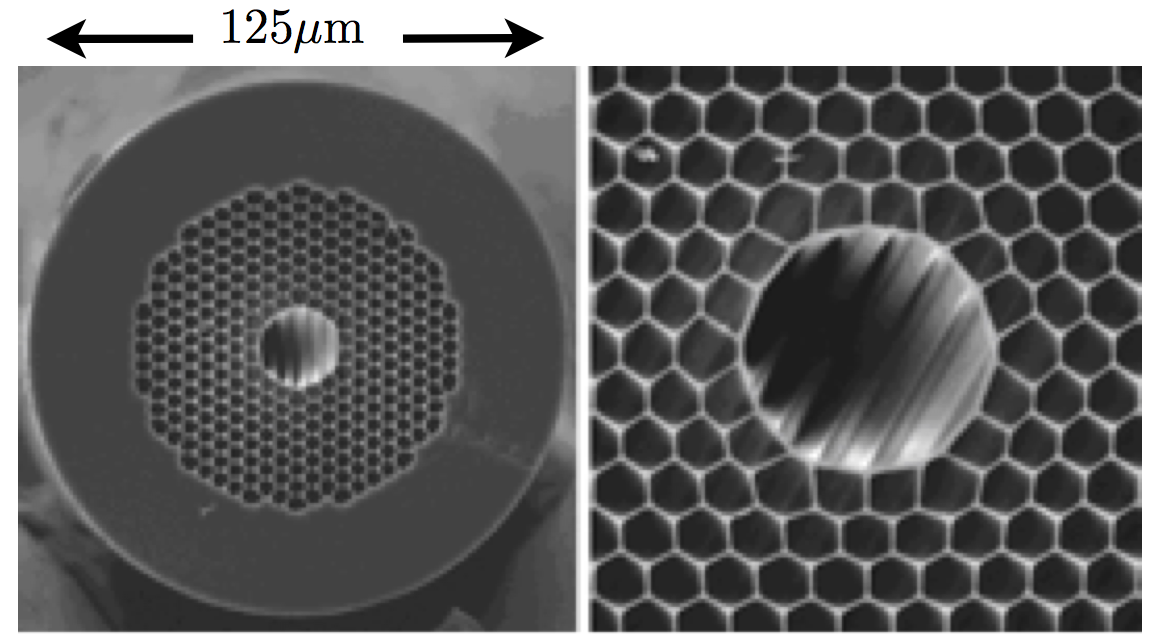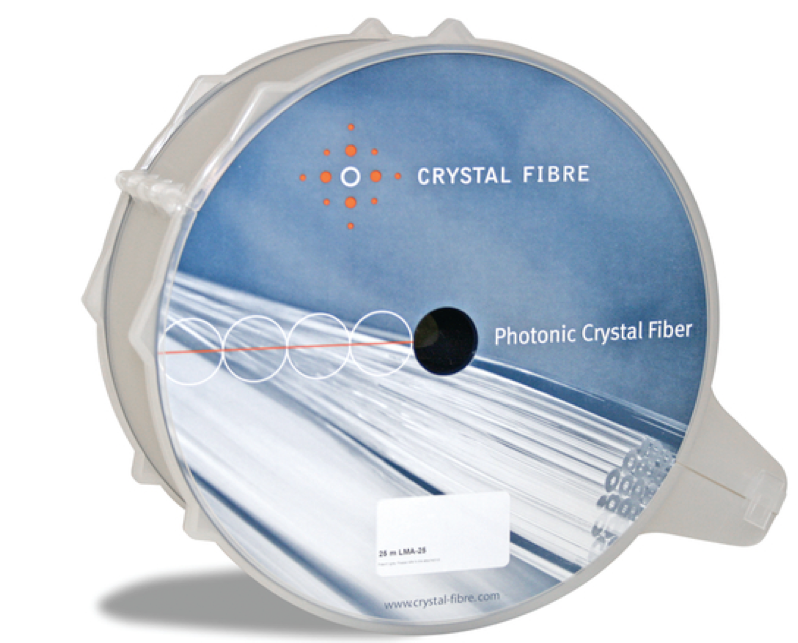Photonic crystal fibre: Creation of a multi million dollar industry
Submitting Institution
University of BathUnit of Assessment
PhysicsSummary Impact Type
TechnologicalResearch Subject Area(s)
Physical Sciences: Other Physical Sciences
Engineering: Materials Engineering
Summary of the impact
Photonic crystal fibres are a new form of optical fibre developed at the
University of Bath from 1996 to the present. Our work has led to the
creation of new companies, new business sectors for established companies
and stock products for large component suppliers. Our key patents (now
sold) continue to dominate technological developments. The estimated
annual world market for photonic crystal fibre is between $35M and $70M.
Users include industries and academic institutions involved in physical
and biomedical imaging, microscopy, spectroscopy, sensing, metrology and
laser gyroscopes.
Underpinning research
Photonic crystal fibres (PCFs) are optical fibres incorporating
carefully-controlled patterns of microscopic air holes. They have
characteristics that are impossible in conventional fibres, such as the
ability to guide light along a hollow core (see figure). The fibre's
inventors Birks, Knight and Russell§ established what is now
the Centre for Photonics and Photonic Materials (CPPM) at the University
of Bath in 1996. They were later joined by Wadsworth, Benabid and Skryabin§.
This group pioneered the design and fabrication of these fibres with
funding from DERA Malvern, EPSRC and JIF and support from the University
of Bath. They have led what has since developed into a continuing
worldwide academic research field and industrial technology.
 The cross section of a hollow-core PCF developed at Bath
The cross section of a hollow-core PCF developed at Bath
The research took place from 1996 and continues to this day. Key
scientific milestones underpinning the impact include:
- Demonstration and understanding of endlessly single-mode PCFs, which
propagate light of any wavelength at a well-defined speed [1]. All
conventional fibres are only single-mode over a limited range of
wavelengths, leading sometimes to a poor profile for the delivered beam.
- Demonstration and understanding of low-loss optical fibres that guide
light in a hollow core surrounded by a "photonic band gap" cladding
[2-4]. This enables delivery of pulse lengths, optical powers and
wavelengths, which are truly unthinkable using conventional fibres.
- Prediction and demonstration of the necessary properties for the
control of strong non-linear interactions in PCFs [5]. This revitalised
the field of nonlinear fibre optics, resulting in a range of
technological and commercial developments as well as new scientific
insights.
§ T.A. Birks (Professor 1996-present), J.C. Knight (Professor
1996-present), P. S-J. Russell (Professor 1996-2005), Wadsworth (Reader
1999-present), Benabid (Reader 1999-2011) and Skryabin (Professor
2000-present).
References to the research
[1](*) TA Birks, JC Knight, PStJ Russell, Endlessly single-mode
photonic crystal fiber, Optics Letters 22 961-963 (1997)
(1703 citations, 2nd most cited paper in the journal's history). http://dx.doi.org/10.1364/OL.22.000961
[2](*) JC Knight, J Broeng, TA Birks and PStJ Russell, Photonic band
gap guidance in optical fibers, Science 282 1476-1478 (1998)
(824 citations). DOI:10.1126/science.282.5393.1476
[3](*) RF Cregan, BJ Mangan, JC Knight, TA Birks, PStJ Russell, PJ
Roberts, DC Allen, Single-mode photonic band gap guidance of light in
air, Science 285 1537-1539 (1999) (979 citations). DOI:
10.1126/science.285.5433.1537
[4] F Benabid, JC Knight, G Antonopoulos, PStJ Russell, Stimulated
Raman scattering in hydrogen-filled hollow-core photonic crystal fiber,
Science 239 399-401 (2002) (374 citations). DOI:
10.1126/science.1076408
[5] WH Reeves, DV Skryabin, F Biancalana, JC Knight, PStJ Russell, FG
Omenetto, A Efimov, AJ Taylor, Transformation and control of
ultra-short pulses in dispersion-engineered photonic crystal fibres,
Nature 424 511-515 (2003) (246 citations). doi:10.1038/nature01798
(*) Best indicators of research quality
Details of the impact
The unique properties of PCFs (described above) open up new ways to
manipulate and control light, benefiting applications such as medical
imaging (eg. fluorescence lifetime imaging, optical coherence tomography
and optical molecular imaging) [6], spectroscopy, physical and biomedical
sensing [7], laser gyroscopes (used in critical navigation and defence
systems) [8] and materials processing.
Commercial activity at Bath began with several key patents filed from
1998 with Birks, Knight and Russell as inventors [9]. Together with a Bath
spin-out company BlazePhotonics, these patents were sold to Danish firm
"Crystal Fibre" for $3.3M in 2004. Now part of NKT Photonics [10], Crystal
Fibre's capability also derived directly from Bath know-how following our
collaboration with its co- founder Broeng [2,11]. The PCFs sold by NKT
Photonics during the REF period were therefore based on our original
expertise and patents. The company also incorporate PCF as a key enabling
component in many of their fibre laser products. In their 2010 Annual
Report, NKT state that the "addressable market for crystal fibers is
valued at around 200-400 mDKK annually" [12], equivalent to $35M-$70M
annually. "Addressable market" is the total size of a market [13].
CPPM remain engaged with the needs of industry and indeed some of NKT
Photonics's newest custom fibre products were supplied directly by us
under contract. Commenting on this deal, the CEO of NKT Photonics said "We
are pleased that we can continue to serve our customers with these leading
edge fibers, and along with the help and expertise of the University of
Bath, demonstrate our continued leadership and commitment in the area of
hollow core fibers" [11].
Several other companies sell systems incorporating types of PCFs
invented, designed and demonstrated by the Bath team, such as Leukos SA
(France) [14] and B&W Tek (USA) [15]. A major PCF application is
microscopy, and the market leading Leica TCS SP8 X confocal microscope
employs PCF in the excitation source [16]. Another key application is the
optical comb marketed by Menlo Systems for precision metrology and
standardisation [17]. Menlo itself arose from the laboratory of one of our
German collaborators, in part because of our contribution to the work for
which he was awarded the Nobel Prize in 2005 [18]. The US military uses
PCF for high-power military sensors and gyroscopes [19].
Throughout the REF period, the leading optical components vendors Newport
Corporation [20] and Thorlabs [21] sold "off-the-roll" PCFs made by
BlazePhotonics and NKT Photonics and based on our designs. They offered 15
and 25 PCF products respectively, priced between £80 and £1100 per metre,
for a variety of industrial and academic applications such as those
described above.
 PCF on a spool, sold by Newport Corporation
PCF on a spool, sold by Newport Corporation
In summary:
- Photonic crystal fibres represent a revolutionary waveguide technology
that was pioneered and developed by the University of Bath team
- Their unique properties have a multitude of applications
- Businesses derived directly or indirectly from our research outputs
serve a worldwide market worth several tens of millions of dollars
annually
Sources to corroborate the impact
[6] F. Begum and Y. Namihira Photonic Crystal Fiber for Medical
Applications, in "Recent Progress in Optical Fiber Research", Edited
by Moh. Yasin, Sulaiman W. Harun and Hamzah Arof ISBN 978-953-307-823-6,
DOI: 10.5772/27739
[7] A.M.R. Pinto and M. Lopez-Amo, Photonic Crystal Fibers for
Sensing Applications, Journal of Sensors, vol. 2012, Article ID
598178, 2012. doi:10.1155/2012/598178
[8] http://www.nktphotonics.com/gyro
(accessed 15/7/13)
[9] For example patents: EP 1340725, EP 1153324, EP1388018, EP1153325,
viewable via http://www.google.com/patents
[10] www.nktphotonics.com (accessed
22/4/13)
[11] NKT Photonics press release at www.nktphotonics.com/news_2010
(accessed 22/4/13)
[12] NKT Photonics: 2010 Annual report page 30:
http://www.nkt.dk/uk/Materials/Annual+reports/2010
(accessed 22/4/13)
[13] http://en.wikipedia.org/wiki/Total_addressable_market
(accessed 22/4/13)
[14] http://www.leukos-systems.com
(accessed 22/4/13)
[15] http://bwtek.com/ (accessed
22/4/13)
[16] http://www.leica-microsystems.com/products/confocal-microscopes/leica-tcs-sp8-configurable-
confocal/details/product/leica-tcs-sp8-x/ (accessed 12/7/13)
[17] www.menlosystems.com (accessed
22/4/13)
[18] See page 165 of Ted Hänsch's Nobel lecture:
http://www.nobelprize.org/nobel_prizes/physics/laureates/2005/hansch-lecture.pdf
(accessed 22/4/13)
[19] http://www.darpa.mil/NewsEvents/Releases/2013/07/17a.aspx
(accessed 18/7/13)
[20] www.newport.com (accessed 22/4/13)
[21] www.thorlabs.com (accessed 22/4/13)